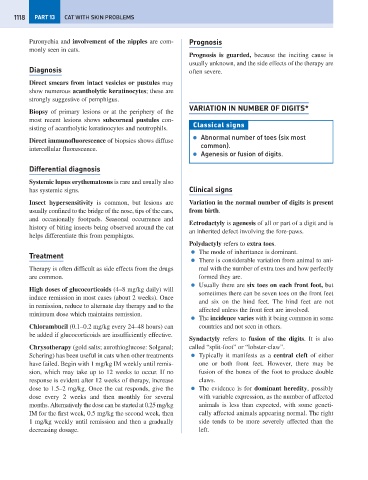Page 1126 - Problem-Based Feline Medicine
P. 1126
1118 PART 13 CAT WITH SKIN PROBLEMS
Paronychia and involvement of the nipples are com- Prognosis
monly seen in cats.
Prognosis is guarded, because the inciting cause is
usually unknown, and the side effects of the therapy are
Diagnosis often severe.
Direct smears from intact vesicles or pustules may
show numerous acantholytic keratinocytes; these are
strongly suggestive of pemphigus.
VARIATION IN NUMBER OF DIGITS*
Biopsy of primary lesions or at the periphery of the
most recent lesions shows subcorneal pustules con-
Classical signs
sisting of acantholytic keratinocytes and neutrophils.
● Abnormal number of toes (six most
Direct immunofluorescence of biopsies shows diffuse
common).
intercellular fluorescence.
● Agenesis or fusion of digits.
Differential diagnosis
Systemic lupus erythematosus is rare and usually also
has systemic signs. Clinical signs
Insect hypersensitivity is common, but lesions are Variation in the normal number of digits is present
usually confined to the bridge of the nose, tips of the ears, from birth.
and occasionally footpads. Seasonal occurrence and
Ectrodactyly is agenesis of all or part of a digit and is
history of biting insects being observed around the cat
an inherited defect involving the fore-paws.
helps differentiate this from pemphigus.
Polydactyly refers to extra toes.
● The mode of inheritance is dominant.
Treatment
● There is considerable variation from animal to ani-
Therapy is often difficult as side effects from the drugs mal with the number of extra toes and how perfectly
are common. formed they are.
● Usually there are six toes on each front foot, but
High doses of glucocorticoids (4–8 mg/kg daily) will
sometimes there can be seven toes on the front feet
induce remission in most cases (about 2 weeks). Once
and six on the hind feet. The hind feet are not
in remission, reduce to alternate day therapy and to the
affected unless the front feet are involved.
minimum dose which maintains remission.
● The incidence varies with it being common in some
Chlorambucil (0.1–0.2 mg/kg every 24–48 hours) can countries and not seen in others.
be added if glucocorticoids are insufficiently effective.
Syndactyly refers to fusion of the digits. It is also
Chrysotherapy (gold salts; aurothioglucose: Solganal; called “split-foot” or “lobster-claw”.
Schering) has been useful in cats when other treatments ● Typically it manifests as a central cleft of either
have failed. Begin with 1 mg/kg IM weekly until remis- one or both front feet. However, there may be
sion, which may take up to 12 weeks to occur. If no fusion of the bones of the foot to produce double
response is evident after 12 weeks of therapy, increase claws.
dose to 1.5–2 mg/kg. Once the cat responds, give the ● The evidence is for dominant heredity, possibly
dose every 2 weeks and then monthly for several with variable expression, as the number of affected
months. Alternatively the dose can be started at 0.25 mg/kg animals is less than expected, with some geneti-
IM for the first week, 0.5 mg/kg the second week, then cally affected animals appearing normal. The right
1 mg/kg weekly until remission and then a gradually side tends to be more severely affected than the
decreasing dosage. left.

